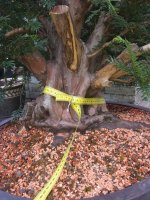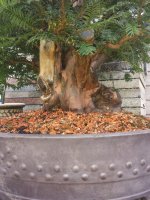This yew was dug from a hedge in May 2020. There were 3 others but I did not have the option of taking care of them and they perished in a field.
It was originally growing in clay, then when I got it it went into the ground in my garden. I put black flower soil around the root(stump)s.
As you can see the branches died back some. I removed bark from dead parts to get a better feel of whats going on.
First time Im dealing with live-veins.
A couple months ago I put it into this pot, mostly in flower soil cause thats what I had lying around. In hindsight I would choose better draining mix.
Cuts that were made:
-initial with chainsaw, turning it from hedge to a plant you have a chance transporting
-selected obviously bad branches and removed them
-where several twigs came from the same place, removed all but one
The roots underneath are the size of the branches but closer together and have highly compacted clay soil in between. Its bloody heavy.
View attachment 392949
Best main trunk:
View attachment 392950
Other main trunk:
View attachment 392951
Branches on soil level are rooted and alive:
View attachment 392952
View attachment 392953
View attachment 392954
Probably the only white root ive ever seen on this tree:
View attachment 392955
Ive never seen the real nebari because I cant afford to cut away any fine surface roots.
Ill probably repot again next year into inorganic soil to avoid grubs and have healthier roots.
The reason I havent done real wiring is because I dont know what exactly Ill use as primary structure








